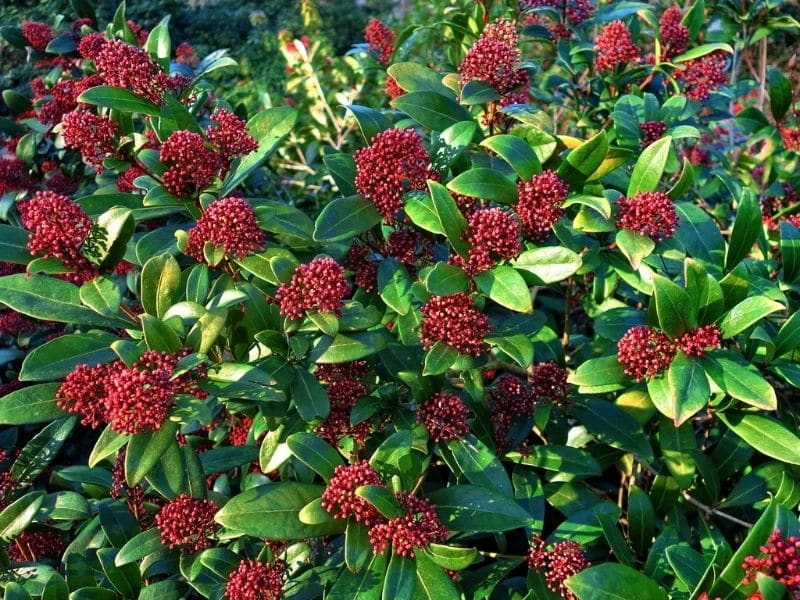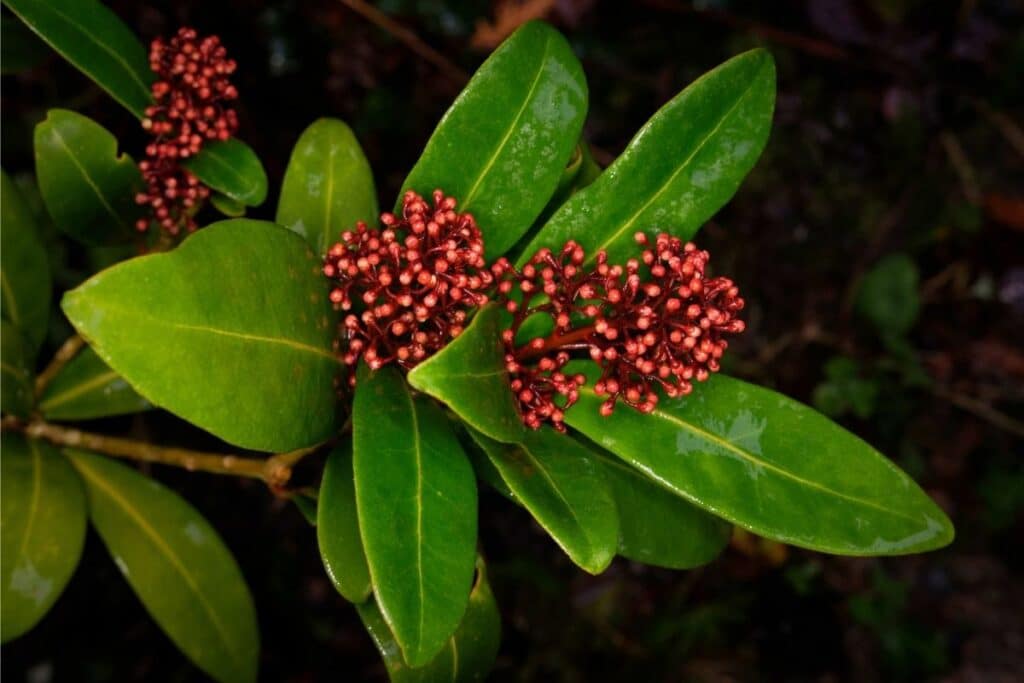Japanese skimmia is a fantastic evergreen shrub for shady areas with a variety of attractive features. Read on to learn more about how to grow and care for this all-year performer.
What Is A Japanese Skimmia?
Skimmia japonica or the Japanese skimmia is an ornamental shrub from the Rutaceae family. These plants have it all, with attractive aromatic foliage, showy fragrant blossoms, and attractive persistent fruits. These naturally neat and rounded evergreen shrubs have a dense growth form.
Wild types of these plants grow to the impressive (but unmanageable) height of about 20 ft (6 m) but horticultural varieties have been developed to be much smaller, usually growing to 4 ft (1.2 m) tall and 5 ft (1.5 m) across or less, depending on the cultivar.
These long-lived, slow-growing plants are native to Southeast Asia, including parts of Japan and China. Skimmia yellow green leaves are 2.5 to 5 inches (6.5 to 12.5 cm) long and narrowly elliptic in shape.
The glossy, dark green foliage occurs in whorls at the ends of branches and is aromatic if crushed.
Flowers
Japanese skimmia flowers are star-shaped and have 4 or 5 petals. These creamy white flowers are about ¼ inch (6 mm) across, although male flowers are slightly larger. These fragrant blooms occur in terminal panicles in the spring months of April to May. (1)
Importantly, most Japanese skimmia varieties are dioecious, meaning separate male and female plants occur. While both sexes will flower beautifully, only the female shrub produces the showy, red fruits that these plants are so popular for.
These persistent fruits will only be produced if nearby male plants fertilize female plants, and for this reason, it is suggested that you plant at least one male to every 6 females.

Skimmia Cultivars and Subspecies
‘Rubella’ is an ideal male cultivar to grow near your female plants because of its beautiful reddish-green foliage. These japanese skimmia shrubs have a compact growth form, reaching 2 to 3 ft (60 to 90 cm) in height and spread. Other male cultivars include ‘Kew Green’ and ‘Fragrans’.
‘Nymans’ and ‘Veitchii’ are good female cultivars that will produce fruits if grown near a male plant.
Skimmia japonica ssp. reevesiana is a self-fertile subspecies that is able to produce fruits without fertilization from another plant. This is a compact plant, reaching a height and spread of less than 3 ft (90 cm), and can be grown in the same way as S. japonica.
How To Grow A Skimmia Shrub
Japanese skimmias can be grown from seed, removed from the fruits. These seeds will benefit from exposure to cold conditions overwinter, causing them to come out of dormancy and germinate in the spring.
Cuttings are also an effective way of growing these plants. Soft, semi-hard, or hardwood cuttings can be used, depending on when they are taken.
These plants can be grown in various soils, but fertile moist soil is definitely favored. Neutral to slightly acidic soil that is well-drained and contains a good amount of organic material will encourage these plants to grow to their full potential.
To improve your soil, mix in some compost or manure when planting and apply a layer of mulch about 2 inches (5 cm) deep on the soil surface under the plant. Remember to leave the space immediately around the stem without mulch to prevent rot.
These skimmia plants are fairly drought resistant but should be watered regularly when young or until established after planting. It’s also a good idea to water your plants in particularly hot and dry conditions, especially if they are planted in very fast-draining soil.
These plants do best when grown in USDA hardiness zones 6 to 8 and UK zone 5. Grow Japanese skimmia bush in a moist shady area, with partial to full shade. Plants grown in full sun, or poor soil, will suffer yellowing, damaged leaves. (2)
Care and Maintenance
One of the best things about Japanese skimmia is its ease of growth and low maintenance needs. These plants are mostly pest and disease-free, although spider mites can occasionally be a concern. Fortunately, rabbits and deer tend to avoid this plant too.
With its naturally tidy form and slow growth rate, this plant does not require frequent pruning. Remove the odd dead or untidy branch but otherwise let this plant grow in its natural form, especially if you want it to produce bright red berries. (3)
These plants usually do not respond well to hard pruning, and it is not recommended. If planted in good, nutrient-rich soil, these plants will not need additional feeding, but you may want to fertilize your plants in the spring if necessary.
Uses
Use this versatile plant for shady areas where it can be used as a specimen plant, for borders, foundations, or plant in the shade underneath larger trees. These plants do great In pots and containers and should be re-potted every 2 to 3 years.
FAQs
Where does skimmia grow best?
Skimmia grows best in moist, well-draining soil with partial to full shade. It thrives in temperate climates and is often found in woodland gardens or shady borders.
Is Japanese skimmia poisonous?
Japanese skimmia (Skimmia japonica) is toxic if ingested, containing compounds that can cause gastrointestinal discomfort and skin irritation. It’s essential to handle the plant with care and keep it away from children and pets.
Why are my skimmia leaves turning white?
Skimmia leaves turning white could indicate powdery mildew, a fungal disease common in humid conditions. Improving air circulation, avoiding overhead watering, and applying fungicides can help manage the issue.
Why are the leaves on my Skimmia turning yellow and dropping?
Yellowing leaves on Skimmia may be due to various factors, including overwatering, underwatering, nutrient deficiencies, pests, diseases, or environmental stressors. Assessing factors such as watering practices, soil condition, and sunlight exposure can help determine the cause and appropriate corrective actions.
What is the best fertilizer for Skimmia?
A balanced, slow-release fertilizer formulated for acid-loving plants is suitable for Skimmia. Apply the fertilizer in early spring before new growth begins, following the instructions on the product label. Avoid overfertilizing, as this can lead to fertilizer burn and other issues.
Conclusion
Japanese skimmia plant is one of those rare shade-loving options that provide interest and attraction throughout the year with its beautiful foliage, fragrant flowers, and fruits. Its neat and tidy growth form and slow growth rate make this a great, low maintenance plant for anyone’s wish-list.
For more shrubs to grow, check our list of garden bushes types.
References
Reference List:
(1) Forrest, M. Landscape Trees & Shrubs: Selection, Use And Management.
(2) Brickel, C. Encyclopedia Of Plants And Flowers. American Horticultural Society.
(3) Brickel, C. & Joyce, D. Pruning & Training: What, When And How To Prune.
Close
*image by GHarder/depositphotos







